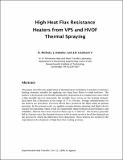HIGH-HEAT-FLUX RESISTANCE HEATERS FROM VPS AND HVOF THERMAL SPRAYING
Author(s)
Michels, D.; Hadeler, J.; Lienhard, John H
Downloadlheaters.pdf (205.2Kb)
Publisher Policy
Publisher Policy
Article is made available in accordance with the publisher's policy and may be subject to US copyright law. Please refer to the publisher's site for terms of use.
Terms of use
Metadata
Show full item recordAbstract
This article describes the application of thermal spray techniques to produce resistance heating elements suitable for applying very large heat flaxes to solid surfaces. The surface to be heated is electrically insulated by deposition of a ceramic layer onto which a thin metallic layer is deposited; the metallic layer serves as the heating element. Each layer has a thickness in the range of 75 to 300 μm. Design considerations for the heaters are described. Previous efforts have produced the films using air plasma spraying. In the present work, we applied vacuum plasma spraying and high-velocity oxygen fuel spraying, which result in considerable improvements in performance and reliability. Heaters have been tested at fluxes up to 17 MW/m2, The heaters generally fail by fracture once the thermal stresses in the system exceed a level that depends on the process by which the films have been deposited. These heaters are useful for the experimental development of high-heat-flux cooling systems.
Date issued
1998-10Department
Rohsenow Kendall Heat Transfer Laboratory (Massachusetts Institute of Technology); Massachusetts Institute of Technology. Department of Mechanical EngineeringJournal
Experimental Heat Transfer
Publisher
Informa UK Limited
Citation
Michels, D., Hadeler, J., & Lienhard V, J. H. (1998). HIGH-HEAT-FLUX RESISTANCE HEATERS FROM VPS AND HVOF THERMAL SPRAYING. Experimental Heat Transfer, 11(4), 341–359.
Version: Author's final manuscript
ISSN
0891-6152
1521-0480